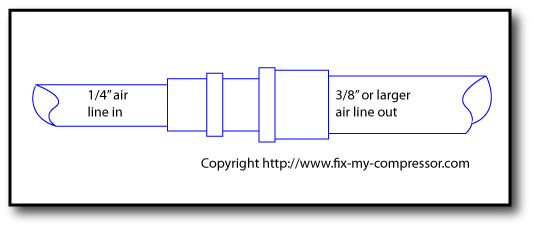Why plug your air compressor into a larger air line?
Consider the design of a typical manufacturing plant compressed air system. The discharge line on a big industrial compressor might be 1 1/2″ in diameter. Then, that line will exit the compressor tank, likely be run up a wall to the ceiling air mains, and bushed up into a much larger, maybe 3″ diameter, air main, or perhaps even larger. That certainly qualifies as a larger air line.
Throughout the plant there are compressed air drop lines taken from the ceiling main down to the various work stations. That’s moving from a larger air line back down to a smaller one to each point of compressed air use. There are good reasons for that, as well.
For your home or small workshop air compressor, you might simply prefer to change the size of the air hose that you plug into your air compressor discharge coupler. A larger air line, going from that small 1/4″ PVC type hose or tube up into a 1/2″ or 3/4″ rubber hose, has benefits.
Are there any problems with plumbing the compressor from a smaller into a larger air line?
Not as far as we are concerned.
To create a larger air line to their air tools, compressor owners can remove the discharge coupler entirely (after dumping all air in the compressor of course) and replace it either with a larger coupler, or an adapter bushing to a larger line size. Install the the appropriately sized larger coupler, and now you can plug larger air lines with larger connectors into your compressor.
Note that increasing the size of the compressor discharge coupler will require a supply of larger connectors for your air hose and air tools too.
The existing compressor discharge coupler can limit air flow

Simply adding a larger air line downstream from the same discharge coupler on your air compressor cannot increase the flow from the compressor, as that will be limited by the air passage way inside the coupler. A larger discharge coupler means more air will flow out of the compressor tank to the air line.
Why a larger air line then?
Just like the example of the plant air supply referred to earlier on this page, if you have a larger air line running from the discharge coupler to your air tool, that line becomes a compressed air reservoir in its own right. You have more compressed air in a larger air line ready to drive your air tool than if the line is smaller.
Both the compressed air pressure and compressed air flow are very important when attempting to do work with a high-demand air tool like a an impact wrench, for example. A larger air line to that tool will get more compressed air flow to it at start up, ramping it up to operating capacity quickly.
Downside?
There is no downside to having a larger air line downstream from a smaller air line.
Having a larger air line getting air to your air tool from your compressor faster does not increase the output of your air compressor, however.
If your air tool uses more air than your air compressor can develop – often the case with smaller, home workshop or garage air compressors – then as the compressed air demand exceeds the compressors ability to supply it the air supply to your air tool will diminish, and the air tool will eventually stop working, since it is using more air than the air compressor can supply, regardless of the size of the air line.
That being the case, you can only stop using the air tool until the air compressor catches up, tank pressure builds, you have more air available for the air tool, and you can start work again.
